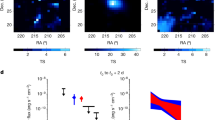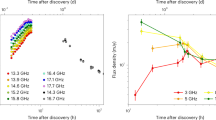Abstract
The ejecta composition is an open question in gamma-ray burst (GRB) physics1. Some GRBs possess a quasi-thermal spectral component in the time-resolved spectral analysis2, suggesting a hot fireball origin. Others show a featureless non-thermal spectrum known as the Band function3,4,5, consistent with a synchrotron radiation origin5,6 and suggesting that the jet is Poynting-flux dominated at the central engine and probably in the emission region as well7,8. There are also bursts showing a sub-dominant thermal component and a dominant synchrotron component9, suggesting a probable hybrid jet composition10. Here, we report an extraordinarily bright GRB 160625B, simultaneously observed in gamma-ray and optical wavelengths, whose prompt emission consists of three isolated episodes separated by long quiescent intervals, with the durations of each sub-burst being approximately 0.8 s, 35 s and 212 s, respectively. Its high brightness (with isotropic peak luminosity Lp,iso ≈ 4 × 1053 erg s−1) allows us to conduct detailed time-resolved spectral analysis in each episode, from precursor to main burst and to extended emission. The spectral properties of the first two sub-bursts are distinctly different, allowing us to observe the transition from thermal to non-thermal radiation between well-separated emission episodes within a single GRB. Such a transition is a clear indication of the change of jet composition from a fireball to a Poynting-flux-dominated jet.
This is a preview of subscription content, access via your institution
Access options
Access Nature and 54 other Nature Portfolio journals
Get Nature+, our best-value online-access subscription
$29.99 / 30 days
cancel any time
Subscribe to this journal
Receive 12 digital issues and online access to articles
$119.00 per year
only $9.92 per issue
Buy this article
- Purchase on Springer Link
- Instant access to full article PDF
Prices may be subject to local taxes which are calculated during checkout



Similar content being viewed by others
Change history
31 January 2018
In the version of this Letter originally published, the letter í was mistakenly omitted from the surname of the author R. Sánchez-Ramírez. This has now been corrected.
References
Kumar, P. & Zhang, B. The physics of gamma-ray bursts & relativistic jets. Phys. Rep. 561, 1–109 (2015).
Ryde, F. et al. Identification and properties of the photospheric emission in GRB090902B. Astrophys. J. 709, L172–L177 (2010).
Band, D. et al. BATSE observations of gamma-ray burst spectra. I—spectral diversity. Astrophys. J. 413, 281–292 (1993).
Preece, R. et al. The first pulse of the extremely bright GRB 130427A: a test lab for synchrotron shocks. Science 343, 51–54 (2014).
Zhang, B.-B., Uhm, Z. L., Connaughton, V., Briggs, M. S. & Zhang, B. Synchrotron origin of the typical GRB Band function—case study of GRB 130606B. Astrophys. J. 816, 72 (2016).
Uhm, Z. L. & Zhang, B. Fast-cooling synchrotron radiation in a decaying magnetic field and γ-ray burst emission mechanism. Nat. Phys. 10, 351–356 (2014).
Zhang, B. & Pe’er, A. Evidence of an initially magnetically dominated outflow in GRB 080916C. Astrophys. J. 700, L65–L68 (2009).
Hascoët, R., Daigne, F., Mochkovitch, R. & Vennin, V. Do Fermi Large Area Telescope observations imply very large Lorentz factors in gamma-ray burst outflows? Mon. Not. R. Astron. Soc. 421, 525–545 (2012).
Axelsson, M. et al. GRB110721A: an extreme peak energy and signatures of the photosphere. Astrophys. J. 757, L31 (2012).
Gao, H. & Zhang, B. photosphere emission from a hybrid relativistic outflow with arbitrary dimensionless entropy and magnetization in GRBs. Astrophys. J. 801, 103 (2015).
Troja, E. et al. Significant and variable linear polarization during the prompt optical flash of GRB 160625B. Nature 547, 425–427 (2017).
Zhang, B. et al. Discerning the physical origins of cosmological gamma-ray bursts based on multiple observational criteria: the cases of z = 6.7 GRB 080913, z = 8.2 GRB 090423, and some short/hard GRBs. Astrophys. J. 703, 1696–1724 (2009).
Hu, Y.-D. et al. Internal energy dissipation of gamma-ray bursts observed with Swift: precursors, prompt gamma-rays, extended emission, and late X-ray flares. Astrophys. J. 789, 145 (2014).
Preece, R. D. et al. The BATSE gamma-ray burst spectral catalog. I. High time resolution spectroscopy of bright bursts using high energy resolution data. Astrophys J. Suppl. S. 126, 19–36 (2000).
Mészáros, P. & Rees, M. J. Steep slopes and preferred breaks in gamma-ray burst spectra: the role of photospheres and Comptonization. Astrophys. J. 530, 292–298 (2000).
Pe’er, A. Temporal evolution of thermal emission from relativistically expanding plasma. Astrophys. J. 682, 463–473 (2008).
Deng, W. & Zhang, B. Cosmological implications of fast radio burst/gamma-ray burst associations. Astrophys. J. 783, L35 (2014).
Murakami, T., Inoue, H., Nishimura, J., van Paradijs, J. & Fenimore, E. E. A gamma-ray burst preceded by X-ray activity. Nature 350, 592–594 (1991).
Pe’er, A., Ryde, F., Wijers, R. A. M. J., Mészáros, P. & Rees, M. J. A new method of determining the initial size and Lorentz factor of gamma-ray burst fireballs using a thermal emission component. Astrophys. J. 664, L1–L4 (2007).
Castro-Tirado, A. J. et al. GRB 021004: tomography of a gamma-ray burst progenitor and its host galaxy. Astron. Astrophys. 517, A61 (2010).
Racusin, J. L. et al. Broadband observations of the naked-eye γ-ray burst GRB080319B. Nature. 455, 183–188 (2008).
Piran, T., Sari, R. & Zou, Y.-C. Observational limits on inverse Compton processes in gamma-ray bursts. Mon. Not. R. Astron. Soc. 393, 1107–1113 (2009).
Zhang, B. & Yan, H. The Internal-Collision-Induced Magnetic Reconnection and Turbulence (ICMART) model of gamma-ray bursts. Astrophys. J. 726, 90 (2011).
Ghirlanda, G., Celotti, A. & Ghisellini, G. Extremely hard GRB spectra prune down the forest of emission models. Astron. Astrophys. 406, 879–892 (2003).
Wang, X.-Y. & Mészáros, P. GRB precursors in the fallback collapsar scenario. Astrophys. J. 670, 1247–1253 (2007).
Proga, D. & Zhang, B. The late time evolution of gamma-ray bursts: ending hyperaccretion and producing flares. Mon. Not. R. Astron. Soc. 370, L61–L65 (2006).
Metzger, B. D., Giannios, D., Thompson, T. A., Bucciantini, N. & Quataert, E. The protomagnetar model for gamma-ray bursts. Mon. Not. R. Astron. Soc. 413, 2031–2056 (2011).
Komissarov, S. S. & Barkov, M. V. Magnetar-energized supernova explosions and gamma-ray burst jets. Mon. Not. R. Astron. Soc. 382, 1029–1040 (2007).
Burrows, D. N. et al. Bright X-ray flares in gamma-ray burst afterglows. Science 309, 1833–1835 (2005).
Ackermann, M. et al. Fermi-LAT observations of the gamma-ray burst GRB 130427A. Science 343, 42–47 (2014).
Ziaeepour, H., et al. Final Swift Observations of GRB 070721B GRB Coordinates Network Report 73 (2007).
Gruber, D. et al. Fermi/GBM observations of the ultra-long GRB 091024. A burst with an optical flash. Astron. Astrophys. 528, A15 (2011).
Zhang, B.-B. et al. Unusual central engine activity in the double burst GRB 110709B. Astrophys. J. 748, 132 (2012).
Abdo, A. A. et al. Fermi observations of GRB 090902B: a distinct spectral component in the prompt and delayed emission. Astrophys. J. 706, L138–L144 (2009).
Burlon, D. et al. Precursors in swift gamma ray bursts with redshift. Astrophys. J. 685, L19 (2008).
Troja, E., Rosswog, S. & Gehrels, N. Precursors of short gamma-ray bursts. Astrophys. J. 723, 1711–1717 (2010).
Lazzati, D. Precursor activity in bright, long BATSE gamma-ray bursts. Mon. Not. R. Astron. Soc. 357, 722–731 (2005).
Zhang, B.-B. et al. A comprehensive analysis of Fermi gamma-ray burst data. I. Spectral components and the possible physical origins of LAT/GBM GRBs. Astrophys. J. 730, 141 (2011).
Zhang, B.-B. et al. An analysis of Chandra deep follow-up gamma-ray bursts: implications for off-axis jets. Astrophys. J. 806, 15 (2015).
Cash, W. Parameter estimation in astronomy through application of the likelihood ratio. Astrophys. J. 228, 939–947 (1979).
Tang, S. M. & Zhang, S. N. Time lag between prompt optical emission and γ-rays in GRBs. Astron. Astrophys. 456, 141–143 (2006).
Beskin, G. et al. Fast optical variability of a naked-eye burst—manifestation of the periodic activity of an internal engine. Astrophys. J. 719, L10–L14 (2010).
Li, Z. & Waxman, E. Prompt optical emission from residual collisions in gamma-ray burst outflows. Astrophys. J. 674, L65 (2008).
Fan, Y.-Z., Zhang, B. & Wei, D.-M. Naked-eye optical flash from gamma-ray burst 080319B: tracing the decaying neutrons in the outflow. Phys. Rev. D. 79, 021301 (2009).
Acknowledgements
B.-B.Z. thanks Y.-Z. Fan, Y.-Z. Wang, H. Wang, K. D. Alexander and D. Lazzati for helpful discussions. We are grateful to K. Hurley, I. Mitrofanov, A. Sanin, M. Litvak and W. Boynton for the use of Mars Odyssey data in the triangulation. We acknowledge the use of the public data from the Swift and Fermi data archives. B.-B.Z. and A.J.C.-T. acknowledge support from the Spanish Ministry Projects AYA2012-39727-C03-01 and AYA2015-71718-R. Part of this work made use of B.-B.Z.’s personal Interactive Data Language (IDL) code library ZBBIDL and personal Python library ZBBPY. The computation resources used in this work are owned by Scientist Support LLC. B.Z. acknowledges NASA NNX14AF85G and NNX15AK85G for support. Z.G.D. acknowledges the National Natural Science Foundation of China (NSFC) (grant 11573014). Y.-D.H. acknowledges support by China Scholarships Council (grant 201406660015). Mini-MegaTORTORA belongs to Kazan Federal University, and the work is performed according to the Russian Government Program of Competitive Growth of Kazan Federal University. A.P., E.M., P.M. and A.V. are grateful to the Russian Foundation for Basic Research (grant 17-02-01388) for partial support. A.P. and S.B.P. acknowledge joint BRICS (Brazil, Russia, India, China and South Africa) grant RFBR 17-52-80139 and 388-ProFChEAP for partial support. R.I. is grateful to grant RUSTAVELI FR/379/6-300/14 for partial support. Observations on Mini-MegaTORTORA are supported by the Russian Science Foundation (grant 14-50-00043). A.V.F. and A.M. thank the Russian Science Foundation (grant 14-50-00043). L.M. and A.F.Z. acknowledge support from INTA-CEDEA ESAt personnel hosting the Pi of the Sky facility at the BOOTES-1 station. H.G. and X.-Y.W. acknowledge NSFC (grants 11603003 and 11625312, respectively). Z.G.D., X.-F.W., B.Z., X.-Y.W., L.S. and F.-W.Z. are also supported by the 973 program (grant 2014CB845800). F.-W.Z. is also supported in part by the NSFC (grants U1331101 and 11163003), the Guangxi Natural Science Foundation (grant 2013GXNSFAA019002) and the project of outstanding young teachers’ training in higher education institutions of Guangxi. L.S. acknowledges support by the NSFC (grant 11103083) and the Joint NSFC-ISF Research Program (grant 11361140349). S.O. acknowledges the support of the Leverhulme Trust. S.J. acknowledges support from Korea Basic Science Research Program through NRF-2014R1A6A3A03057484 and NRF-2015R1D1A4A01020961, and I.H.P. through NRF-2015R1A2A1A01006870 and NRF-2015R1A2A1A15055344. R.A., D.F. and D.S. acknowledge support from RSF (grant 17-12-01378). A.K. acknowledges the Science and Education Ministry of Kazakhstan (grant 0075/GF4).
Author information
Authors and Affiliations
Contributions
B.-B.Z. led the Fermi data analysis, modelling and physical explanations of GRB 160625B. B.Z., Z.G.D. and X.-Y.W. proposed the theoretical models to explain the data. B.-B.Z. and B.Z. wrote the manuscript. A.P. and P.M. participated in determination of the best spectral model for the sub-burst A and the physical model of the sub-burst B. P.-H.T.T., Y.-D.H. and F.-W.Z. helped with the data analysis and made the plots. A.J.C.-T., A.V., S.J. and S.K. worked on the Gran Telescopio CANARIAS photometry and spectroscopy. A.Ca., A.P., S.B., E.M., A.V., A.M. and V.S. reduced additional optical data. A.K., R.I., O.B., V.R., E.K. and A.M. conducted additional optical observations. G.B. and S.K. reduced the Mini-MegaTORTORA data. L.M., A.F.Z., A.Cw., R.O. and A.Z. worked on the Pi of the Sky data. All authors contributed to the manuscript.
Corresponding authors
Ethics declarations
Competing interests
The authors declare no competing financial interests.
Additional information
Publisher’s note: Springer Nature remains neutral with regard to jurisdictional claims in published maps and institutional affiliations.
A correction to this article is available online at https://doi.org/10.1038/s41550-018-0387-2.
Electronic supplementary material
Supplementary Information
Supplementary Table I–V, Supplementary Figure 1–8 and Supplementary References
Rights and permissions
About this article
Cite this article
Zhang, BB., Zhang, B., Castro-Tirado, A.J. et al. Transition from fireball to Poynting-flux-dominated outflow in the three-episode GRB 160625B. Nat Astron 2, 69–75 (2018). https://doi.org/10.1038/s41550-017-0309-8
Received:
Accepted:
Published:
Issue Date:
DOI: https://doi.org/10.1038/s41550-017-0309-8
This article is cited by
-
A long-duration gamma-ray burst with a peculiar origin
Nature (2022)
-
A peculiarly short-duration gamma-ray burst from massive star core collapse
Nature Astronomy (2021)
-
Gamma-ray bursts as cool synchrotron sources
Nature Astronomy (2019)
-
A peculiar low-luminosity short gamma-ray burst from a double neutron star merger progenitor
Nature Communications (2018)



